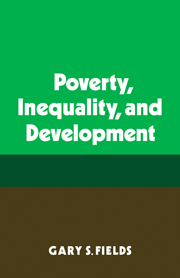Book contents
- Frontmatter
- Contents
- Preface
- 1 Introduction: a new approach to poverty, inequality, and development
- 2 Approaches to income distribution and development
- 3 Growth and distribution: a welfare economic analysis
- 4 Inequality and development
- 5 Absolute income, absolute poverty, and development
- 6 Development progress and growth strategies: case studies
- 7 Development progress and growth strategies: conclusions
- Notes
- Bibliography
- Index
7 - Development progress and growth strategies: conclusions
Published online by Cambridge University Press: 07 October 2009
- Frontmatter
- Contents
- Preface
- 1 Introduction: a new approach to poverty, inequality, and development
- 2 Approaches to income distribution and development
- 3 Growth and distribution: a welfare economic analysis
- 4 Inequality and development
- 5 Absolute income, absolute poverty, and development
- 6 Development progress and growth strategies: case studies
- 7 Development progress and growth strategies: conclusions
- Notes
- Bibliography
- Index
Summary
This book has explored distributional aspects of economic development in poor countries. At issue are two fundamental questions: Which countries upgraded the economic positions of their poor most quickly? What combinations of circumstances and policies led to differential performance? The main results are as follows.
1. Absolute poverty was alleviated in some countries but not in others. Absolute poverty and absolute incomes were the subject of Chapter 5. Information was compiled for thirteen countries in Table 5.7. Those data showed ten countries (Bangladesh, Brazil, Costa Rica, Pakistan, Puerto Rico, Singapore, Sri Lanka, Taiwan, Thailand, and Mexico) in which poverty had diminished to varying degrees. Absolute poverty was not ameliorated in the other countries (Argentina, India, and the Philippines); poverty increased noticeably in all three.
2. Relative inequality increased in some countries and declined in others. Chapter 4 addressed relative inequality. Data on economic growth and changing inequality in thirteen LDCs were presented in Table 4.6. (Several other countries were excluded because of questions about the quality of the data.) For this group of countries, the evidence shows that inequality rose in seven (Argentina, Bangladesh, Brazil, El Salvador, Mexico, the Philippines, and Puerto Rico); fell in five (Costa Rica, Pakistan, Singapore, Sri Lanka, and Taiwan); and is mixed but leaning toward a slight decline for one country (India).
3. The absolute poverty and relative inequality measures agree in some cases and disagree in others. Qualitative agreement (i.e., with respect to direction of change) appears in seven countries.
Information
- Type
- Chapter
- Information
- Poverty, Inequality, and Development , pp. 239 - 244Publisher: Cambridge University PressPrint publication year: 1980
